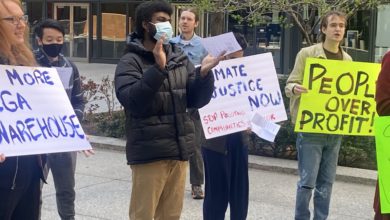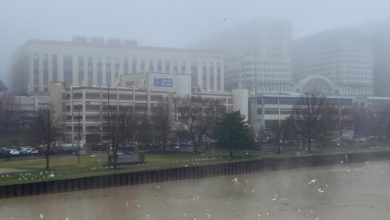According to researchers, three of the 90 orca whales—also called killer whales—that live in the Puget Sound are missing and presumed dead. One of the missing whales, a 12-year-old female known as K-28, or “Raven,” leaves behind a still-nursing, four-month-old calf that likely will now perish.
“When you’re losing a breeding female at the beginning of the reproductive years, that’s very significant,” said Kelly
 |
Whale pod populations have increased since the 1970s, when capturing orcas for aquariums was banned. However, the numbers are now declining again. Of the three missing whales, two showed signs of starvation the last time they were sighted.
Why are orcas starving in Puget Sound?
Orcas eat salmon, and salmon populations are declining due to pollution in the Sound. The whales also are being affected by the buildup of industrial chemicals such as PCBs, which impact reproduction and the immune system.
Pollution in the Sound has many causes. One cause is stormwater runoff. Chemicals like fertilizers and pesticides that have been put on fields and lawns are washed into the streams and end up in the Sound when it rains. The paving over of farmland also contributes to the runoff problem, as pavement is not absorbent, leading to an increase in runoff. Tons of sewage are also dumped in the Sound.
The issue of PCBs harming marine mammals is relatively complex. PCBs, which were used to make flame-retardant clothing, were banned in the U.S. in 1977. However, the levels in whales have been increasing lately.
These chemicals are hard to clean up once they have entered the marine food cycle. Mud and water are contaminated with PCBs. Algae and microscopic plants absorb the PCBs from the mud. Small invertebrates then eat the algae. Small fish eat the invertebrates, which are eaten by larger fish like salmon, which then are eaten by orcas.
The effect of this food cycle concentrates the PCBs in the fat of the orcas and the salmon, resulting in elevated levels of PCBs in these animals nearly 30 years after the chemical was banned.
PCBs and other contaminants are also found at higher land elevations. They can then be released as global warming melts snow packs and glaciers.
“There’s an awful lot of environmental contaminants that are locked up in snow packs in the Olympics and Cascades,” said Steve Jeffries, a scientist with Washington State Fish and Wildlife. When the snow melts, the runoff ends up in the Sound.
Now, there are new chemical flame retardants that could cause similar environmental and health problems. These are called polybrominated diphenyl ethers, or PBDEs, which are similar to PCBs.
The PBDEs, which are added to seat cushions, mattresses and electronic devices, get into the environment as foam cushions fall apart and plastics break down. Scientists have found that these chemicals can affect liver and thyroid function and cause behavioral and developmental problems following high exposure in the womb.
A chemical manufacturers’ trade group claims that PBDEs are safe. But scientists’ research about PBDEs in the Puget Sound shows them acting like PCBs—getting trapped in marine life and concentrated in the food chain.
Peter Ross, a scientist with the Department of Fisheries and Oceans Canada, predicted that “PBDEs are likely to overtake PCBs as the No. 1 chemical in terms of concentration in killer whales.”
Capitalists pollute the Sound
Because the Sound is like a deep tub with a shallow underwater ledge at its northern end, it is hard for the ocean to flush it out and dilute the contaminants. However, even if the pollution could be flushed out into the ocean, that would just exacerbate the pollution of the ocean. The real solution is to try to clean up the existing pollution and prevent further pollution.
The stormwater runoff issue could be addressed in several ways. Rigorously enforced limits on real-estate development could prevent the unfettered paving of farm and grassland. The use of dangerous pesticides and fertilizers could be banned.
But, in a series on the Sound, the Seattle Post-Intelligencer lamented: “For years, government officials and scientists have known that polluted stormwater poses one of the greatest threats to the Sound. And they know how to fix it. But so far, no one has had the political nerve or money to match the threat.”
Another source of pollution comes from capitalist enterprises that flout existing regulations intended to protect the Sound.
For example, the Nichols Brothers boatyard has repeatedly been fined and cited for actions that damage the Sound. While launching a $45 million paddleboat using an unapproved ramp, the boat became stuck in the mud and had to be pulled out with tugboats, which tore up 65,000 square feet of eelgrass, habitat for tiny fish critical to the Puget Sound food chain.
The boatyard also has put up temporary buildings without the required permits, installed an unapproved septic system, and filled in wetlands and ripped up tidelands without a permit.
“I think they have a motto that is: ‘Catch me if you can,’” said Christine Goodwin, president of Friends of Holmes Harbor, a group that monitors the health of the harbor. “They do what they need to do to build that boat.” Officials responsible for enforcing the regulations routinely allow violations to avoid “substantial economic consequences” for the company or its clients.
Three county commissioners responsible for protecting the Sound are supporters of the boatyard; one county commissioner is a former Nichols Brothers manager. The problem is more than corruption. It is emblematic of the fact that the state apparatus under capitalism exists to protect the interests of the capitalist class. The laws that exist to protect the environment were products of political struggle by the environmental movement.
Meanwhile, orcas continue to die as salmon in the Sound also risk extinction. The endangerment of marine mammals such as orca whales and salmon serves as a warning that the shortsighted approach of capitalist industry is in danger of permanently destroying the natural environment shared by all living beings.






